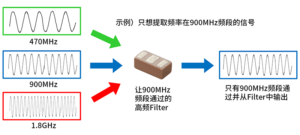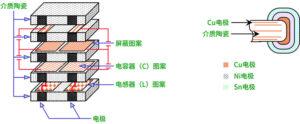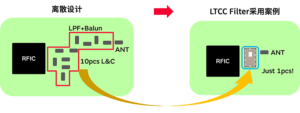A filter is a component that extracts only the required parts from a given signal and removes unnecessary parts. Additionally, this utility is referred to as filtering. High frequency refers to the higher frequency part of waveforms such as radio waves and sound waves. A high-frequency filter is a component that allows the desired frequency signal to pass through and block unwanted frequency signals. This type of filter is sometimes referred to as an RF filter.

LC filter is a component composed of an inductor (L) and a capacitor (C), which can block unwanted frequency signals or only allow the desired frequency signal to pass through.

A multi-layer LC filter is constructed using LTCC (low-temperature co fired ceramic) with low temperature coefficient and printed copper wire coils. By making L and C into multi-layer structures, miniaturization has been achieved. By changing the coil pattern or capacitor pattern, the waveform of the filter can be changed.

LTCC stands for Low Temperature Co fired Ceramics, which refers to low-temperature co fired ceramics. The characteristic of LTCC is that by mixing glass components in ceramic materials typically fired at high temperatures above 1500 ° C, the firing temperature can be reduced to around 900 ° C.
The advantages of using LC filters
The following is the circuit diagram of LPWA (Low Power Aria Network) as an example. The left image uses 10 inductors (L) and capacitors (C) to form an 868MHz low-pass filter+balun. The figure on the right is an example of using an LC filter and replacing it with a single component. The use of LC filters brings the following four advantages.
·Easy to design
·Reduce component deviation
·Reduce design space
·Reduce the number of components

According to the different extraction frequencies, LC filters can be roughly divided into four types.
Low Pass Filter (LPF)
Filter that extracts only the low-frequency (Low) side frequency. Because it is a filter that allows frequencies below the blocking frequency to pass, it is called a low-pass filter.
.
High Pass Filter (HPF)
Filter that extracts only the high-frequency (High) side frequency. Because it is a filter that allows frequencies higher than the blocking frequency to pass through, it is called a high pass filter.

Band Pass Filter (HPF)
Extract only filters within a specific frequency range. Because it is a filter that only allows the set frequency range to pass, it is called a bandpass filter.

Band Elimination Filter (BEF)
Because it is a filter that only blocks a specific frequency range, it is called a band stop filter.

Insertion Loss
Insertion loss, also known as IL, is an English term for insertion loss.
IL refers to the amount of signal loss in the desired frequency band when passing through the product, measured in dB. If IL is good, it is called low loss or low IL of the filter. If the IL is poor, the desired signal will be lost, making it impossible for the signal to pass through. Therefore, it can be said that products with good IL characteristics are high-quality products.
Attenuation
Attenuation, also known as ATT, is the amount of attenuation in English.
Attenuation refers to the amount of attenuation, in dB, of a signal in the desired frequency band as it passes through the product. If the attenuation is good, it is said that the attenuation of the filter is high or large. If the attenuation is poor, unwanted noise and other signals will pass through. When designing with a focus on IL, the attenuation characteristics tend to deteriorate, so filter developers will consider the balance between IL and attenuation characteristics for development.
Reflection characteristic: Return Loss
The reflection characteristic is called Return Loss, abbreviated as RL.
Return Loss refers to the amount of signal reflected when inputting a signal into the product, measured in dB. If the Return Loss is good, the amount of signal that needs to pass through the filter will be smaller, which means more signals will pass through the filter without being reflected.
Band Width
The passband width is called Band Width in English, abbreviated as BW.
The passband width is the frequency band allowed for a signal to pass through, measured in Hz.

